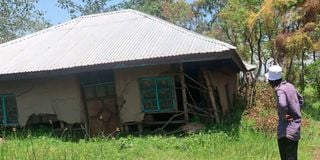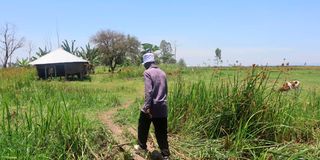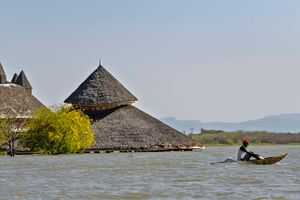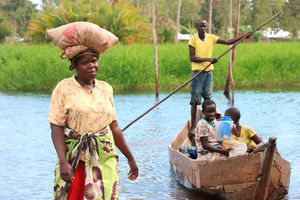The pain of living on borrowed land after lake swallows villages

Maurice Otieno, a resident of Ahero, Kisumu County, walks past a house that was destroyed by Lake Victoria.
What you need to know:
- In 2020, experts from the Lake Victoria Basin Commission warned that the lake had bulged to a historical new high and had reached 13.42 meters. This scientific warning is now a reality.
- In Ahero, Kisumu County, scientists say human activities are to blame for flooding, decrying that their expertise has largely been ignored by communities.
On the days that the skies are painted grey and the commanding sound of thunder deafens their ears, they dash to their houses for shelter hoping that raindrops will not soak in their slippery grounds and eventually stay afloat.
There, when it rains, it pours with an uncalled-for exaggeration.
For decades, generations of people in parts of the western side of Kenya have been frowning at the rain.
So entrenched is the flooding crisis that in Budalangi, Busia County, a local artist has composed a song to lament on the nuisance of floods.
In Ahero, Kisumu County, scientists say human activities are to blame for flooding, decrying that their expertise has largely been ignored by communities.
Now, part of Lake Victoria has joined the rain in causing havoc and families are worried that they are likely to live on borrowed land in future, one which will alienate them from their ancestors and culture. Already, the latest data from the World Population Data Sheet by the Population Reference Bureau (PRB) indicates a projection of population increase in the country from the current 54 million to about 85 million people by mid-2050.

A man rows a boat on part of a lake that was previously a residential area in Ahero.
Population increase, if the PRB projections are anything to go by, will likely have detrimental effects on people living in flood-prone areas. This is even as rising Lake Victoria’s waters continue to displace hundreds of families.
There is an expected calm as we drive to Ogenya village in Ahero. Trees are swaying in a composed way. The sun is out and the air is garden-fresh. The reality of people living on borrowed land becomes clearer as we move closer to Lake Victoria, Africa’s largest inland freshwater lake.
Residents have made makeshift houses, indicating the temporary nature of their stay. Most houses are made of corrugated iron sheets and some are tents made of polyvinyl chloride laminated fabric branded with donor logos. Only those who dare the wrath of the swelling lake have built mud houses, and a few have erected permanent structures.
As we get closer, it becomes dangerous to use our vehicle as the previous dry land has now become mushy and most of it has enjoined the lake. From afar, we see submerged houses and traces of water hyacinth. One house has a boat in its front yard, parked like a car. Schools and hospitals have been abandoned. We pass scores of defaced houses, most of which visibly show house frames detached from the mud that clothed them before the floods.
Makeshift bridges have been placed at strategic places to ease movement. Fisher folks are going on with their preparation business in an area that was previously someone’s land. They lay their nets and sew those that have been destroyed. Women carry mats made from papyrus reeds as they take them to their makeshift homes for drying. Business seems to be as usual, but residents live in fear.

Makeshift tents of residents affected by floods in Budalangi pitched at someone else’s land.
“What if the lake displaces us again? Where will our children live in future? How can we change this?” Asks Maurice Otieno, a village elder in Ogenya village as he rows the boat to take me to a 15-acre land that has been submerged by the lake.
“I wish there existed a remote control that could have a pause function such that when it's about to rain, we press, pause and go on with our lives. Rain is like a nightmare to us," laments Maurice.
More than anything, the future worries him even as he is oblivious of the mistakes his community made that may have contributed to the flooding menace that comes head-on every time it rains.
“I have seven children and I now live in a rented house. Some of my children are adults and there is no way I can share a small rented house with them. This means that I have to rent two other houses, one for the girls and another for the boys. It pains me that I have to do this when I know that I have enough land to build houses. It has been three years since I was displaced and I am not sure if I will go back there soon,” he tells Health Nation.
In 20 years, Maurice's first child will be 42. Presumably, he will have children. He, however may not live on their ancestral land, not because he chooses to, but because of a forceful natural eviction as the lake continues to bulge.

A resident uses a man-made bridge in Ahero, Kisumu in mushy areas near homes that have been submerged by Lake Victoria.
In 2020, experts from the Lake Victoria Basin Commission warned that the lake had bulged to a historical new high and had reached 13.42 meters. This scientific warning is now a reality.
A few metres from Maurice’s former home is Elizabeth Akinyi’s new home. The 48-year-old lives with her husband and two of her co-wives at their home that sits on a five-acre land. Elizabeth’s husband bought the land after their home was submerged in the lake. As if the lesson is not home yet, they still bought land not very far from the lake.
“I have six children. My two co-wives have seven children altogether. My husband decided to buy land because we used to live at the camp after we were displaced and life there was unbearable. At least now we have a house made of iron sheets that are not easily swept away by the floods. I don’t know what I will do when we are displaced again. We will just move to another place. Do we have any other option?” She poses.
Elizabeth’s first child is 28 and married. He, too, stays there with his family. His children will know this new home as their ancestral home only if the lake does not force them to relocate –again.
Unlike in Ahero where residents have accepted the fate and moved to higher grounds, residents of Mabinju village in Budalangi still hope to go back to their homes.
According to locals, the first major flooding episode began almost 100 years ago. And just a year before Kenya got independence, a devastating flood also hit the region in 1962. However, the residents who spoke to Healthy Nation believe that the ongoing floods are the worst despite the water dying down in some areas.
We find 36 year-old Godfrey Kwamala, who is in charge of about 102 households at Budala Camp, preaching at a local church. While his sermon reiterates the need for living harmoniously as a community, one of his congregants, Josephine Saidi, is worried about her next move. Josephine was displaced by the lake waters. She lives in a tent at someone’s homestead. Subtly, yet evidently, the owner of the home feels that Josephine and other people who have pitched their tent at his home have overstayed.
“We are on our way out. We don’t know when, but we can tell that we may not last here. The unsaid is quite clear. We just don’t know who will accept us next. This is my second time, in three years, to move my tent to a different home,” Josephine tells Healthy Nation.
Kwamala, who was born and raised in this area, is worried that the lake will permanently displace more and more people until the resources become scarce.
“Unverified information has it that the lake, by 1960, had moved about 15kilometres to people’s land. Until this year, we suspect that five more kilometres have been occupied by the lake. The backflow from the lake has worsened the situation. This started in 2019. It was the first time we witnessed a backflow. Previously, only heavy rains that caused river banks to break caused the floods. Now we have double trouble,” says Kwamala.
“When the pandemic struck, we lost most of our older people, not because of Covid-19 but because of stress related to being forced to move from their ancestral homes. When, for instance, a widow was asked to move to a higher ground, she felt disintegrated from her dead kin. She wanted to stay close to them even if it meant living in the waters.
“But some locals were adamant, and died. Others accepted to go to higher grounds but still died of unknown reasons. We suspect that the stress played a part .”
As we drive past Sigiri Bridge, there are some dykes that have been set up to prevent flooding when it rains. However, down the river, some residents are harvesting sand, a human activity that scientists say contributes to flooding.
Nobert Nyandire, a climate change expert who is also an environment and spatial planner, faults residents for encroaching land that is supposed to be occupied by the lake.
“We have seen cases of people replacing the natural ecosystem by setting up buildings near the lake. In Ahero for instance, farming has been rampant uphill and when it rains, due to the loose soil, water freely flows downhill to areas near the lake. Ahero is known for rice farming and the pipes used in the irrigation scheme are sometimes linked directly from the lake. Such activities cause a ripple effect especially during rainy seasons,” he says.
He explains that the swelling of the lake may be caused by scientific factors such as shifting of the tectonic plates, which make water levels rise.
The tectonic plates act like two blocks moving in a slow pace towards each other. Should the two collide and cause any fracture, water bodies take the shape of the newly formed fault line and this forces more water to be pumped to the earth surfaces; leading to phenomenon like rising lakes.
“This is just a type of landform that causes water to stress at an equal level and eventually rise,” says Nyandire.
“We have some laws like the Physical Planning Act but people still live in riparian land. Siltation is also a way that contributes to flooding and all we need is the implementation of policies that guide the usage of shared water resources,” he adds.
Prof Simon Onywere, a lecturer and researcher specialising in Environment Planning and Management, was one of the scientists who researched on the phenomenon of the rising lakes in the country.
“We cannot ignore and live in the riparian land even when the buffer zones (areas around the lake) are small. Such zones need to be respected. Our law has set up the buffer zone distance in metres yet it should be in several kilometres to avoid the effect of the backflow encroaching in people’s lands. We need a flood plain area near the lakes. It is absurd that some people cultivate up to the lake’s shores and even build. In case there will be a flooding problem, such buildings will be submerged,” he explains.
Prof Onywere says climate change may have a part in the stubborn backflow of the lake.
“Right now it is not raining on the Eastern side of the rift valley but on the west like Kisii, there are torrential rains. The drainage system of the lake should be at the optimal flow now. We are experiencing a shift from the norm and this is in terms of onset of the rainy season, its intensity and duration. The climate is affecting this, we are witnessing the changes and we need to act before it is too late,” he says.
He advises landowners that nature, despite being dynamic, has its defined territory and going back to the land after the water dies down is a gamble.
“To avoid such problems in future, the government should ensure that people do not live in risk prone areas,” he says.





